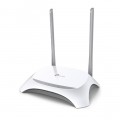 Loading... Please wait...
Loading... Please wait...Categories
Our Newsletter
- Home
- Modem/Router
- D-Link 300Mbps Pre-N Router DIR-612
Product Description
SPECIFICATION
- Model Variations: D-Link, like other manufacturers, often releases slightly different versions of the same basic model. These versions might have minor hardware or firmware revisions that affect specific features.
- "Pre-N" is Ambiguous: The term "Pre-N" suggests it's an older router that supports a draft version of the 802.11n Wi-Fi standard. This means the exact features might vary significantly.
- "Support all Cable Networks" is Vague: While it implies compatibility, it doesn't give technical details about the modem (if it's a cable modem router combo) or WAN (Wide Area Network) connection types supported.
General Specifications I Can Provide (Based on Typical 300Mbps Pre-N Routers):
Wireless (Wi-Fi):
- Standard: Likely 802.11n (draft version) - offering speeds up to 300Mbps (in ideal conditions). It would also be backward compatible with 802.11g and 802.11b.
- Frequency Band: Probably 2.4GHz (common for older Wi-Fi routers).
- Antennas: Likely 2 or 3 external antennas (possibly detachable).
- Security: WPA/WPA2 encryption, WPS (Wi-Fi Protected Setup).
Wired Connections:
- Ethernet Ports:
- Typically 4 x 10/100 Mbps LAN ports (for connecting computers/devices to the router).
- 1 x 10/100 Mbps WAN port (for connecting to a cable modem).
- Cable Connection: This is the biggest unknown. It could be:
- DOCSIS Cable Modem Built-in: If it's a cable modem router combo, it would have a coaxial cable connector. The DOCSIS version (2.0, 3.0, etc.) is crucial information that's missing.
- Standard Ethernet WAN: It might rely on an external cable modem, connecting via the WAN port.
To Find the EXACT Specifications:
- Look for a Model Number: The most crucial piece of information is the exact model number of the D-Link router. It's usually found on a sticker on the bottom or back of the device.
- Search Online: Once you have the model number, search for it on D-Link's website or other tech websites. You should find the official specifications and documentation.
- Check the Device Itself: If you have the router, the specifications might be printed on the device's label or included in the user manual.


















